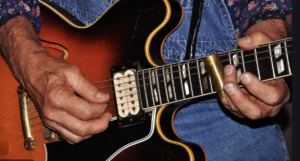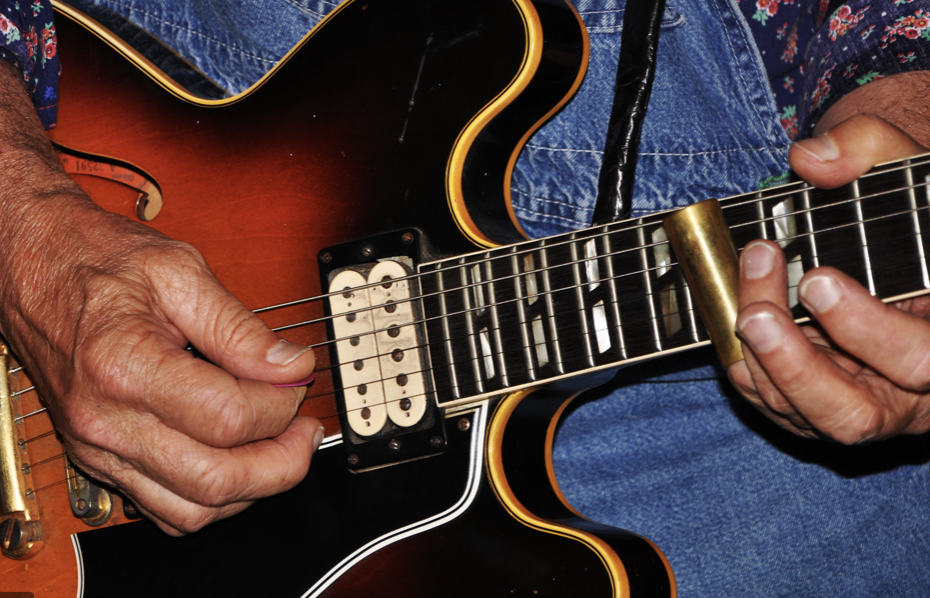Guitar slide is a technique of guitar playing that revels a different side of the instrument. The melodic power of guitar slide makes it an important weapon in the guitar player arsenal.
In this article you’ll see a number of techniques and strategies you can use to learn guitar slide.
The Fundamental Guitar Slide Concepts
We can divide the general strategy to learn guitar slide in four major steps.
 In the first step, you need to learn a variety of essential slide guitar concepts.
In the first step, you need to learn a variety of essential slide guitar concepts.
The first concept to understand the philosophy of slide: the melodic element and the freedom of playing the guitar independent of frets. The slide itself is quickly learned, once you have the proper setup.
An important step for the setup is to select a guitar that works well with slide techniques. The selection of the pickup is the most important.
The action is also another important part of the setup: a very low action can make it difficult to use a guitar with the slide.
Chord Techniques
Another important step in learning the slide is to be able to mute notes and chords. This is almost as important as producing the sound in the first place. For this, you will need to develop you right hand coordination.
Another area that you need to be careful is with pitch precision: unlike the traditional guitar techniques, when playing slide you cannot be sloppy on finger location: this may make your sound completely out of pitch.
Slide Equipment
Another area when setup is important is on selecting string gauges. You should experiment with different gauges and select the one that makes you more comfortable. Sometimes, thicker gauges will work better in this scenario.
A kind of equipment that you need to evaluate is the amp used with slide. You need to remember that the sound characteristics of the standard guitar are different from the slide sound.
The same care needs to be taken with the effects used on your slide guitar. The standard effects may not work in the way you’re used to.
Adding Color
The first stages of your slide playing will focus on adding color to your sound. Getting past the frustrating early stages can be a great challenge, and need to be addressed.
Despite this, you need to look at what guitar slide has to offer to you as a guitarist: a different feeling than the standard fingerstyle or pick style of playing.
Rhythm and Solo
Once you have conquered the basics, it is time to work on more rhythmic material for your slides. This can be done playing simple chords, soloing, and combining these with interesting fills.
You need to figure out when to use solo slide and how this style can be combined with fills, when necessary. Also remember that slide guitar is a simple style, compared to finger style. Learn to use less, but using your imagination.
You also need to concentrate on how to create and build solos. This is needed to develop your own personal freedom when playing slide. The result of this is mastering “expression” on your instrument, the key to artistry in the guitar.
Slide Tunning
Slide guitar techniques require the use of different tunings to achieve new effects. You can develop licks and tips for each tuning, as you gain more experiment with them. Here are some tunings that can be used:
- Standard Tuning,
- Open E tuning (with G string tuned to G#).
- D Tuning (with low E tuned to D)
- The Magic G String: By altering the pitch of JUST your G string while your guitar is tuned to an E or D chord, you can create a whole new palette of amazing sounds and colors.
- Open A tuning (E A E A C# E).
- Open G Tuning (D G D G B D).
Finally, you can master all this by improvising solos on a set of songs. This will be the best way to illustrate the forms and approaches to soloing over a variety of feels and tempos. I suggest you to practice the solos over backing tracks and then breaks them down emphasizing the concepts and techniques you’re studying.
Learning More About Guitar Slide
If you really want to master guitar slide techniques, I suggest you to buy the full slide guitar video course. This course will cover all the topics I described above, and more.
This course explains and demonstrates all of the key concepts and approaches along the way. You’ll get standard notation and tabs for each of the soloing performance studies. The instructor includes all of the rhythm tracks for you to work with on your own. In addition, you’ll be able to loop or slow down any of the videos so that you can work with the lessons at your own pace.
